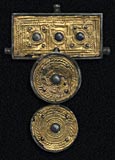Jewellery of the Goths
Adornments and articles of attire
 |
Various
groups of tribes who inhabited part of the territory currently
belonging to Poland from the first to the forth century
A.D., can be distinguished from others by the burial rites
and grave goods that were specific to their way of life.
This archaeological culture is known in current scholarly
literature as the Wielbark culture. The name originates
from a cemetery located in Malbork-Wielbark. The archaeological
investigations conducted in the last decades proved beyond
all doubt that this culture can be identified with the Goths
themselves. The term Wielbark culture is often used interchangeably
with Goths' culture. |
The
evidence of the Goths' presence in what is currently Poland is
still not well-known and is connected, first of all, with the
cemeteries in which rich graves have been often discovered. Among
the many goods with which the dead were equipped, one can find
delicately ornamented and perfectly made pendants, necklaces,
bracelets and jewellery clasps. The objects were often made of
silver or gold using complicated goldsmith techniques, like gilding,
filigree and granulation. Unfortunately, despite the evidence
of such elaborate jewellery technology, no goldsmith workshops
have been discovered.
Inspiration
for this exhibition dedicated to Goths' jewellery has come from
the recent discoveries made in the little village of Kowalewko
near Oborniki Wielkopolskie. Archaeological excavations undertaken
during the construction of the transit gas pipeline from Russia
to Western Europe resulted in the discovery of an extensive cemetery
composed of 496 graves, some of which contain quite unique artefacts.
It is worth mentioning that this site is the largest thoroughly
examined cemetery in Greater Poland (Wielkopolska) and one of
the largest in the entire country.
Besides
the archaeological artifacts discovered in Kowalewko, objects
from many other Gothic cemeteries in Northern Poland have also
been presented in this exhibition.
|

